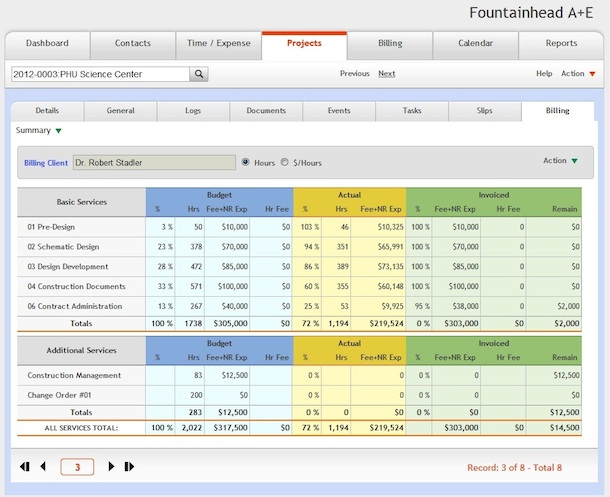They started with just 2 employees and a big dream—to be a premier high-end, multidisciplinary firm, able to provide clients with a full range of services. They wanted to meet and exceed the most discerning clients’ expectations and have Vertical Arts’ vision stamped on every aspect of production.
Since Vertical Arts opened its doors in ’05, they’ve been using ArchiOffice to handle billing and project management. They had fluctuations like everyone else during the roughest years of the recession, yet they’ve more than quadrupled their staff and have plans to expand even more in the coming years.
Their revenue has gone up 300-350% in eight years’ time. Their accountant has even started recommending ArchiOffice to neighboring firms.
They’re able to offer a full service architectural experience—coordinating surveyors, helping clients orchestrate moves or get home inspections done, and allowing consultant billing to come through them.
How Do They Do It?
They Invoice in Half a Day or So
Using ArchiOffice means they can get billing done for all their complex projects in half a day to a day. So all employees’ hours are always billable, and Parker, the company’s only administrative employee can tackle billing efficiently, getting on to his other responsibilities. “If we didn’t have ArchiOffice, we’d have to hire at least one more person, part or full time,” he admits. Instead, they can take on more jobs and projects because their staff isn’t tied up doing administrative work.
They Organize Projects Ridiculously Well
Parker explains: “We have one specific project that we’ve chosen to divide into with 9 sub-projects, so that we can individually track time and expense per sub-project. And ArchiOffice keeps that whole world organized for us. ArchiOffice allows us to manage more jobs and projects with still just one support staff member.”

Since Vertical Arts opened its doors, the firm has been using ArchiOffice to handle billing and project management. The firm can get billing done for their projects in less than a day.
Their Client Relationships are Rock Solid
“It streamlines our process and gives us access to tons of information and reports quickly so we don’t spend much time answering questions for clients—we just generate it and send it right back. I know our clients trust our billing and our process. It’s really strengthened our client relationships.”
They Became an Incredibly Impressive Firm
“Overall ArchiOffice is just a great billing and project management software—to be able to go to one place and see all your time, all your budgets, all your invoices and transactions, it just streamlines the administrative side significantly,” explains Parker.
Now, Vertical Arts doesn’t have to settle for taking on uninspiring projects. They do most of their work with a number of individual clients. They’ve achieved their dream of being a multidisciplinary high-end firm—they have an interior designer on staff, a landscape architect, as well as a full architectural team, so they’re able to provide the full range of services they know their clients deserve.
Learn more about ArchiOffice Software here.
Check out Vertical Arts Architecture here.
Related Stories
Sustainable Development | May 10, 2024
Nature as the city: Why it’s time for a new framework to guide development
NBBJ leaders Jonathan Ward and Margaret Montgomery explore five inspirational ideas they are actively integrating into projects to ensure more healthy, natural cities.
Mass Timber | May 8, 2024
Portland's Timberview VIII mass timber multifamily development will offer more than 100 affordable units
An eight-story, 72,000-sf mass timber apartment building in Portland, Ore., topped out this winter and will soon offer over 100 affordable units. The structure is the tallest affordable housing mass timber building and the first Type IV-C affordable housing building in the city.
Architects | May 8, 2024
Ivan O’Garro, AIA joins LEO A DALY as a vice president
Integrated design firm LEO A DALY welcomes Ivan O’Garro, AIA, as a vice president and managing principal of its Atlanta studio.
K-12 Schools | May 7, 2024
World's first K-12 school to achieve both LEED for Schools Platinum and WELL Platinum
A new K-12 school in Washington, D.C., is the first school in the world to achieve both LEED for Schools Platinum and WELL Platinum, according to its architect, Perkins Eastman. The John Lewis Elementary School is also the first school in the District of Columbia designed to achieve net-zero energy (NZE).
Healthcare Facilities | May 6, 2024
Hospital construction costs for 2024
Data from Gordian breaks down the average cost per square foot for a three-story hospital across 10 U.S. cities.
Biophilic Design | May 6, 2024
The benefits of biophilic design in the built environment
Biophilic design in the built environment supports the health and wellbeing of individuals, as they spend most of their time indoors.
MFPRO+ Special Reports | May 6, 2024
Top 10 trends in affordable housing
Among affordable housing developers today, there’s one commonality tying projects together: uncertainty. AEC firms share their latest insights and philosophies on the future of affordable housing in BD+C's 2023 Multifamily Annual Report.
Retail Centers | May 3, 2024
Outside Las Vegas, two unused office buildings will be turned into an open-air retail development
In Henderson, Nev., a city roughly 15 miles southeast of Las Vegas, 100,000 sf of unused office space will be turned into an open-air retail development called The Cliff. The $30 million adaptive reuse development will convert the site’s two office buildings into a destination for retail stores, chef-driven restaurants, and community entertainment.
Codes and Standards | May 3, 2024
New York City considering bill to prevent building collapses
The New York City Council is considering a proposed law with the goal of preventing building collapses. The Billingsley Structural Integrity Act is a response to the collapse of 1915 Billingsley Terrace in the Bronx last December.
Architects | May 2, 2024
Emerging considerations in inclusive design
Design elements that consider a diverse population of users make lives better. When it comes to wayfinding, some factors will remain consistent—including accessibility and legibility.

















